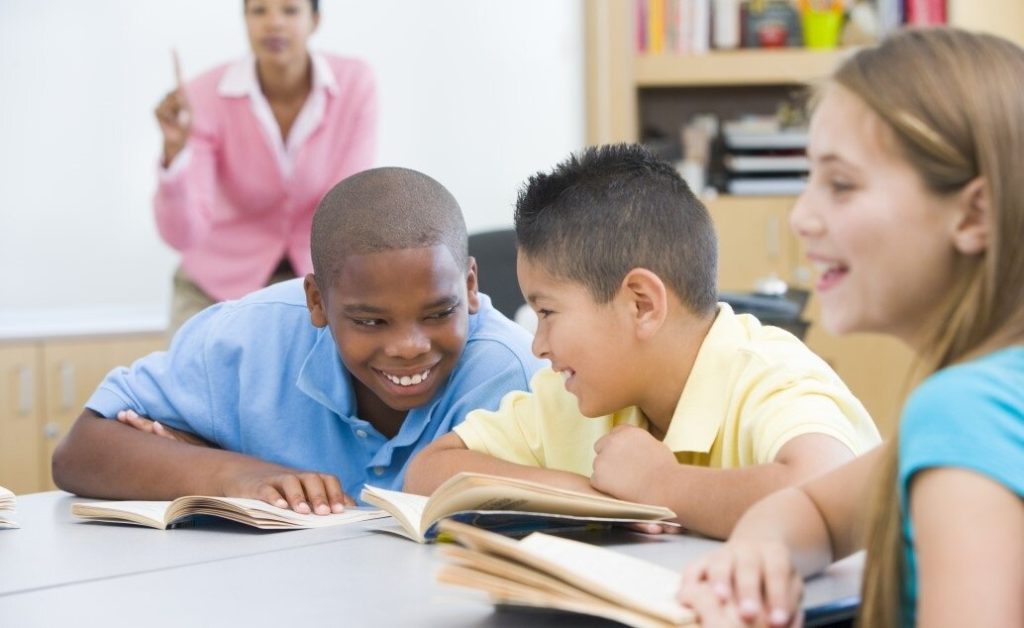
My first year in education, I taught in a third-grade bilingual classroom with an animated group of nearly 30 English language learners. I remember beaming with pride during my first walk-through with my old principal as she praised how quiet my students had been that day. Looking back, I cringe when I think about that noiseless classroom. Learning is an inherently social process, and by falling for the myth that a silent classroom is an effective one, I was actually neglecting the linguistic development of my students.
Avenues (2007), a curriculum for English learners, reminds us that students must be continuously engaged in “cooperative learning strategies…in content-rich activities” in order to “promote self-expression, interaction skills, proper use of language structures, and vocabulary development.” And, if you’re an English as a Second Language, foreign language, or language immersion teacher, talk becomes a way of continuously developing students’ speaking skills in a non-threatening, meaningful way.
Is Your Class a Ping Pong Match or Pinball Machine?
At a recent staff development, my new principal shared that communication in effective classrooms should be like a pinball machine rather than a ping-pong match.
In a ping-pong match, the dialogue bounces back and forth between two people–usually the teacher and a single student. At best, this leaves the rest of the class to listen while the verbal ping-pong match carries on. More often, however, this leaves the rest of the class tuned out of the conversation or pursuing other, less desirable behaviors instead.
Under the pinball machine model, the teacher “launches” a question to the class. A handful of students answer while their peers may respond in agreement or respectfully challenge a classmate’s idea. Other students may pose a related question or ask for clarification. The teacher responds, redirecting the conversation with more questions or suggesting another idea. In this model, there is less back-and-forth dialogue and more free-flowing, student-centered discussion.
How Can You Get the Ball Rolling?
Of course, this all sounds ideal on paper, but where do you even start?
In my own work, I have found that establishing social norms sets the stage for effective, respectful dialogue. Model proper body language while students dialogue. That means facing the speaker, making eye contact, nodding attentively and minimizing distractions.
You’ll also want to coach students on how to decide who answers first, ask probing questions, request clarification, or respectfully disagree.
Practice makes perfect, so group students in teams of three and present them with a question or topic they would enjoy discussing. Give each team a checklist of social skills that have been practiced and reinforced in class. As two of the team members chat, the third person can use the checklist to assess his or her peers’ interactions. After a few minutes, the students rotate and a new student is given the list. After three rounds, allow students to debrief and share their observations using their following prompts:.
- What did they do well?
- Which skills were hardest to implement and why?
- How could conversations be improved in the future?
Mix It Up and Encourage Balanced Conversations
Once students have gotten comfortable practicing as partners, have them dialogue in larger groups of four to six. Before presenting a topic or question, present students with a list of personal goals from which to select that day. Some examples might include:
Finding and expressing a point of agreement with another person,
Taking turns speaking without interrupting, or
Asking a related question to deepen conversation.
At the end of their discussions, let students write a brief reflection in response to their goal for that day. In what ways did they reach their goal? What were some barriers to reaching the goal? What parts of the conversation went well?
Another strategy for encouraging balanced conversations is one I call “Conversation Cubes.” After dividing students into small groups and presenting a topic or question, provide groups with a handful of red, yellow, green, and blue cubes. Each time a student shares a related idea or comment pertaining to the topic, they take a green cube. If students ask a clarifying or challenging question, they take a yellow cube. A red cube represents respectfully disagreeing with another student, and a blue cube represents agreeing with another person’s thought. This strategy not only helps you monitor and assess students’ conversations, but also encourages students to be self-aware.
Keep Your Expectations Balanced Too
My classroom didn’t turn into a “pinball machine” overnight. It took time to let go of the idea that “silent” equals “productive,” and it also took lots of trial and error to set my students on a path toward productive dialogue. But, once you establish clear social norms, provide linguistic support, and offer students a healthy amount of practice, you’ll find your classroom transformed.
Make your classroom the best it can be by reaching your full teaching potential. American College of Education’s master’s degree programs in education can get you there.

